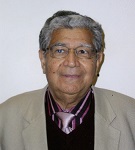
Rameshwar K. Sharma
Distinguished Professor
Salus University
USA
Biography
Born in Jammu-Tawi, India. After receiving Bachelor’s degree in Pharmaceutical Technology from the Birla Institute of Technology, Pilani, India, Rameshwar K. Sharma in 1960 entered the University of Connecticut for graduate work in Medicinal Chemistry and received his Ph.D. in 1963. Subsequently, after several Post-doctoral positions, including at the Worcester Foundation for Experimental Biology, Shrewsbury, Massachusetts, he joined the University of Tennessee Medical Center at Memphis in 1970 where he rose to the rank of Full Tenured Professor of Biochemistry and Physiology. During this period through NIH Special Fellowship he spent two-years Sabbatical as a Visiting Professor at the McArdle Laboratory University of Wisconsin, Madison, in Dr. Henry Pitot’s lab, and subsequently additional two-years Sabbatical at the NIH, Bethesda in Dr. Michael Cashel’s lab. After Full Professorship at the Case Western University and Founder and Head of the Unit of Regulatory Biology at the Cleveland Clinic Foundation, Cleveland Ohio, he joined the University of Medicine and Dentistry at New Jersey as the Professor and Head of The Unit of Regulatory and Molecular Biology. Since July 2006 he is at the Salus University as a Distinguished Professor of Biochemistry and Molecular Biology. In a period spanning four decades, his research team has dedicated itself to the advancement of the field of membrane guanylate cyclase in the vertebrate systems. A few of its core findings that have impacted this and the field of cellular signal transduction follow. (1) With the discovery of the first membrane guanylate cyclase, ANF-RGC that was also the hormone receptor of ANF, the membrane guanylate cyclase surface receptor family was established. (2) It had a unique signal transduction mechanism. Instead of GTP in G-Protein signaling, it was regulated by ATP through its ARM module (ARM). The complete dissection of the module, followed through the concept-based analysis, localized a WTAPELL motif that controlled the entire signal transduction process, it was, then, predicted that this motif is the one that controls the ANF-RGC-dependent blood pressure in vasculature. This has now been proven true through the construction of the mouse genetic model. The mice lacking this motif are hypertensive. (3) The discovery and molecular characterization of the photoreceptor ROS-GC is a land mark event in the phototransduction field. It filled in the gap on the identity of the source of cyclic GMP that serves as a second messenger of the LIGHT signal; and made it possible to explain the principles of phototransduction in molecular and physiological terms. It also impacted the core membrane guanylate cyclase field by branching it into two: a transducer of both the hormone receptor and the intracellularly-generated Ca2+ signals. (4) ROS-GC field took additional direction when it was demonstrated that, besides phototransduction, it is biochemically linked with the transduction mechanisms of the inner segments of the retina, olfactory cilia and the olfactory bulb neurons. (5) The demonstration that ROS-GC is a Ca2+-bimodal switch, generated a new revolutionary concept where theoretically ROS-GC could be modulated through two different modes of Ca2+ signaling: via Ca2+-sensor GCAPS and S100B, the latter stimulating it and the mode found exclusively in cones and absent in rods. (6) Recently, an additional model of the photoreceptor ROS-GC1 has been disclosed. ROS-GC1 is responsive to the bicarbonate signal; it is not the pH effect, rather it binds to a specific motif of the ROS-GC and transduces the signal in generation of cyclic GMP. Preliminary findings suggest that this novel transduction system is present in a small number of mouse cones, and, importantly, is absent in the rods. This opens up a new area of sensory transduction mechanism, where it is meant to communicate with the external atmospheric carbon dioxide. The carbon dioxide is sensed through carbonic anhydrase, whose subtype has been detected in some cones, it converts CO2 to the bicarbonate, which, then, becomes the second messenger of CO2 and a signaling agent of ROS-GC1. Threaded through this past history and step-by-step gain in the field, This investigator feels fortunate that his group has made these important contributions in generating the field of membrane guanylate cyclase, establishing that cyclic GMP is an ubiquitous intracellular second messenger in prokaryotes and eukaryotes and that it plays a critical role in the control of physiological processes of cardiac vasculature, smooth muscle relaxation, blood volume, cellular growth, sensory transduction, neural plasticity, learning and memory. It is also gratifying to know that during this course he has been able to train and guide more than 35 doctoral and post-doctoral students, author 184 peer-reviewed research articles, including the editorship of three books, Special Editorship of two journals of Molecular and Cellular Biochemistry and the e-book editor of the Frontiers Molecular Neuroscience Research Topic, all focused on the field of membrane guanylate cyclases. At present I am on the editorial board of four international journals: Associate editor of the Frontiers in Molecular Neuroscience, Journal of Molecular and Cellular Biochemistry, Journal of Signal Transduction, Journal of Membrane Science & Technology. I am also the founding father and the President of the Guanylate Cyclase Innovative Biotechnology (www.gcibiotechnology.com).
Research Interest
Research Interest: Membrane guanylate cyclase in the vertebrate systems
